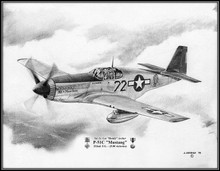 Loading... Please wait...
Loading... Please wait...- Home
- Combat Aircraft/Pencil Drawings ~ Free Shipping
- North American P-51C "Mustang" (1st.Lt. Lee 'Buddy' Archer) ~ Free Shipping
Product Description
Print Size 8½" x 11" ~ Unlimited print edition
P-51B and P-51C USAAF P-51B-10-NA. In April 1942, the RAF's Air Fighter Development Unit (AFDU) tested the Mustang at higher altitudes and found its performance inadequate, but the commanding officer was so impressed with its maneuverability and low-altitude speeds that he invited Ronnie Harker from Rolls Royce's Flight Test establishment to fly it. Rolls-Royce engineers rapidly realized that equipping the Mustang with a Merlin 61 would substantially improve performance and started converting five aircraft as the Mustang X. Ministry official Sir W.R. Freeman lobbied vociferously for Merlin-powered Mustangs, insisting two of the five experimental Mustang Xs be handed over to Carl Spaatz for trials and evaluation by the U.S. 8th Air Force in Britain. The high-altitude performance improvement was astonishing: the Mustang X AM208 reached 433 mph (697 km/h) at 22,000 ft and AL975 tested at an absolute ceiling of 40,600 ft. After sustained lobbying at the highest level, American production of a North American-designed Mustang, with the Packard Merlin V-1650 engine replacing the Allison, was started in early 1943. The pairing of the P-51 airframe and Merlin engine was designated P-51B or P-51C, B (NA-102) being manufactured at Inglewood, California, and C (NA-103) at a new plant in Dallas, Texas, in operation by summer 1943. The RAF named these models Mustang III. In performance tests, the P-51B reached 441 mph/709.70 km/h (exactly two-thirds supersonic speed at altitude) at 25,000 ft (7.600 m) and the subsequent extended range made possible by the use of drop tanks enabled the Merlin-powered Mustang to be introduced as a bomber escort. P-51Bs and Cs started to arrive in England in August and October 1943. The P-51B/C versions were sent to 15 fighter groups that were part of the 8th and 9th Air Forces in England, and the 12th and 15th in Italy (the southern part of Italy was under Allied control by late 1943). Other deployments included the China Burma India Theater (CBI). Allied strategists quickly exploited the long-range fighter as a bomber escort. It was largely due to the P-51 that daylight bombing raids deep into German territory became possible without prohibitive bomber losses in late 1943. A number of the P-51B and P-51C aircraft were fitted for photo reconnaissance and designated F-6C.
Warranty Information
null








